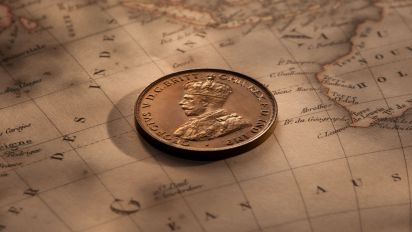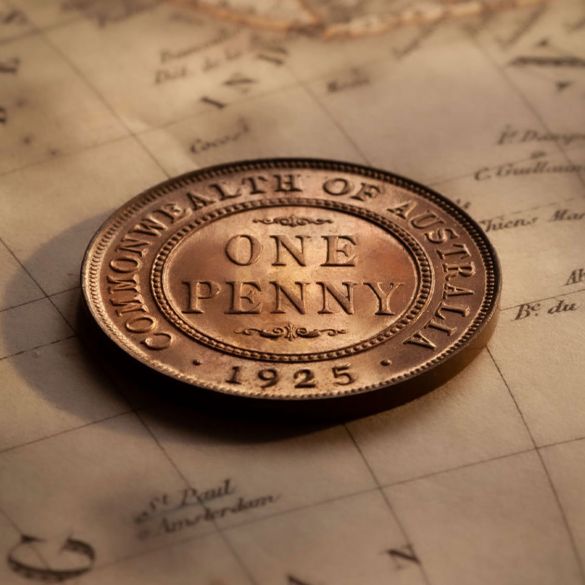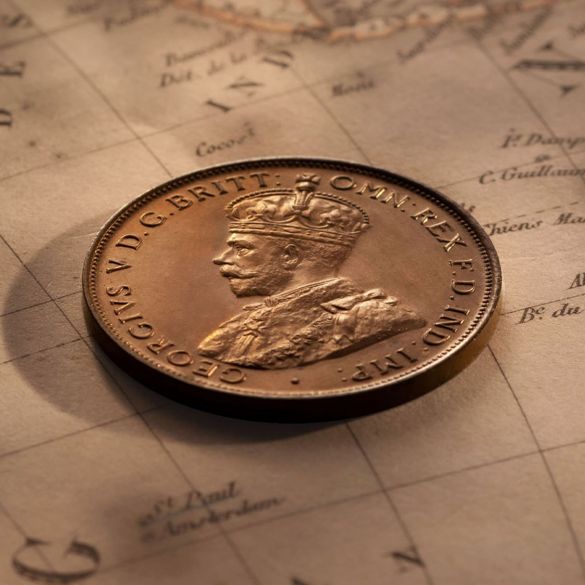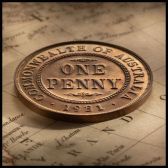Australian numismatic royalty, the Syd Hagley Proof 1925 Penny.



The Proof 1925 Penny is Australian numismatic royalty, a Coin of Record struck at the Melbourne Mint.
In the context of the Australian penny series, it is second only in prominence to the famous Proof 1930 Penny.
Their 'greatness' stems from the fact that both coins are proof strikings of Australia's rarest pennies, the 1925 Penny with a recorded mintage of 117,000. The 1930 Penny believed to be 1500.
In an environment where pennies were struck in the millions, these mintage figures are amazingly scarce.
But, there is another reason why these two coins are so highly valued. Australians just love their 'coppers'.
The penny is an evocative coin, producing memories, ideas, emotions and responses like no other.
The humble penny is as Australian as you can get and people from all walks of life, and across all incomes, identify with our nation's copper coins.
The Hagley Proof 1925 Penny is a brand that promises, and delivers, an experience. The coin is legendary. And in a league of its own.
• In the numismatic industry, the development of a brand starts with an extraordinary quality coin.
And the Hagley Proof 1925 Penny is such. The coin is a full brilliant mint red, gem proof. Its state of preservation borders on the miraculous and it is, unequivocally, the finest of the three known examples.
• The brand develops with an outstanding performance in the public domain, firming its standing and establishing its reputation.
At its first auction appearance in October 1977, the Hagley Proof 1925 Penny fetched $1700 on a pre-auction estimate of $700. Four years later, in March 1981, the coin fetched $10,000 on a pre-sale estimate of $3000. Indeed, the coin has appeared at auction four times from 1977 to its most recent appearance in 2008 and on each occasion, it has sold at a price at least double that of its pre-sale estimate.
Proof coins command respect and proof coins command admiration.
Ask collectors why they pursue proof coins over circulating currency and the prestige of owning a proof coin is most likely at the top of their list.
It's the euphoria that comes with owning something that looks spectacular and that very few other people can ever possess.
In some respect, proof coin collectors are playing it smart because the inherent rarity of proof coinage provides a level of assurance that the market will never be inundated with examples, protecting their investment.
And while all proof coins are desirable ... some are more desirable than others.
Within the proof coin market there is a hierarchy with some proofs ranked more important than others.
Right at the 'top of the tree' for importance and hence value are the proofs of coins that have a rare date status as circulating currency.
So, the rarer the coin as circulating currency, the higher the value of its proof coin counterpart.
There are four rare date Australian pennies, 1925, 1930, 1931 and 1946. (No proofs were struck of the 1946 Penny.)
The Proof 1930 Penny is at the 'top of the tree' for importance.
It is a proof striking of Australia's rarest circulating penny, the industry contending that 1500 pennies were accidentally struck in 1930 and released into circulation.
Next in importance, the Proof 1925 Penny.
A proof striking of Australia's second rarest circulating penny, the 1925 Penny, records indicating that 117,000 coins were struck and released into circulation.
Third in line for importance, the Proof 1931 Penny, records indicating that 474,000 pennies were struck in 1931 for circulation.
To better appreciate the minuscule nature of these mintages, more than 2.1 million pennies were released into circulation in 1932 and in the following year, more than 5.8 million pennies were issued..


Numismatic Royalty - Australia's top three rare-date proof pennies.

Ranking #1
The Proof 1930 Penny

Ranking #2
The Proof 1925 Penny

Ranking #3
The Proof 1931 Penny
Australian Pre-decimal Coins that were struck as proofs - but not destined for collectors - are technically referred to as Coins of Record.
The term, COIN OF RECORD, is to a large extent self-explanatory. It is a coin that has been minted to put on record a date. Or to record a design.
What is not self-explanatory is that Coins of Record were struck to PROOF quality as presentation pieces. And were struck in the most minute numbers satisfying the requirements of the mint rather than the wants of collectors. Forget the notion of striking ten thousand proofs as collectors are accustomed to today. Let's talk about striking a total of ten coins ... or maybe less!
For today’s collectors the Coins of Record offer a wonderful link to the past and are extremely rare, two reasons that make them so popular.
There was no commercial angle in the production of Coins of Record. The mints were not out to make money from the exercise. Quite the reverse, striking a proof coin in our pre-decimal era was a very labour intensive (and hence costly) exercise that would have dented the mints annual budget quite considerably. The prime reason why so few coins were struck.
In the striking of a proof coin, the mint’s intention was to create a single masterpiece, coining perfection. Perfection in the dies. Wire brushed so that they are razor sharp. Perfection in the design, highly detailed, expertly crafted. Perfection in the fields, achieved by hand selecting unblemished blanks, polished to create a mirror shine. Perfection in the edges to encase the design … exactly what a ‘picture frame does to a canvass’.
A proof is an artistic interpretation of a coin that was intended for circulation. A proof coin is meant to be impactful, have the ‘wow’ factor and exhibit qualities that are clearly visible to the naked eye. A proof coin was never intended to be used in every-day use, tucked away in a purse. Or popped into a pocket.
So, what happened to these Coins of Record? Where did they go? And if they were struck by the mints for their own use, how did they get into collector's hands?
In the main, Coins of Record ended up in the mint’s own archives, preserving its history for future generations. Any coins that were surplus to requirements may also have been sent to a museum or public institution.
Coins of Record were also put on display at public Exhibitions. The two known examples of the Proof 1866 Sovereign and Proof 1866 Half Sovereign were especially struck to exhibit as ‘products of New South Wales’ as part of the Colonial Mints display at the International Colonial Exhibition of 1866 and the International Exposition in Paris, 1867. They were discovered in London in the early 1970s.
It is noted that many of the overseas mints have over time sold off Coins of Record that they considered excess to their requirements allowing them to come into collector's hands. The Royal Mint South Africa sold off several Australian gold proofs in the 1990s
© Copyright: Coinworks